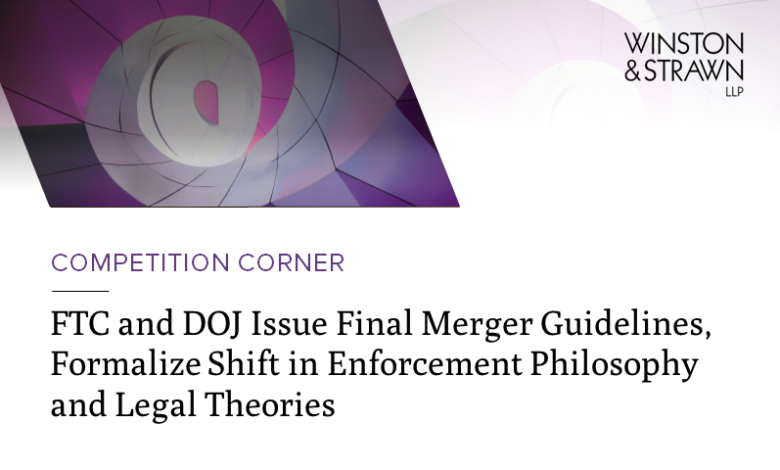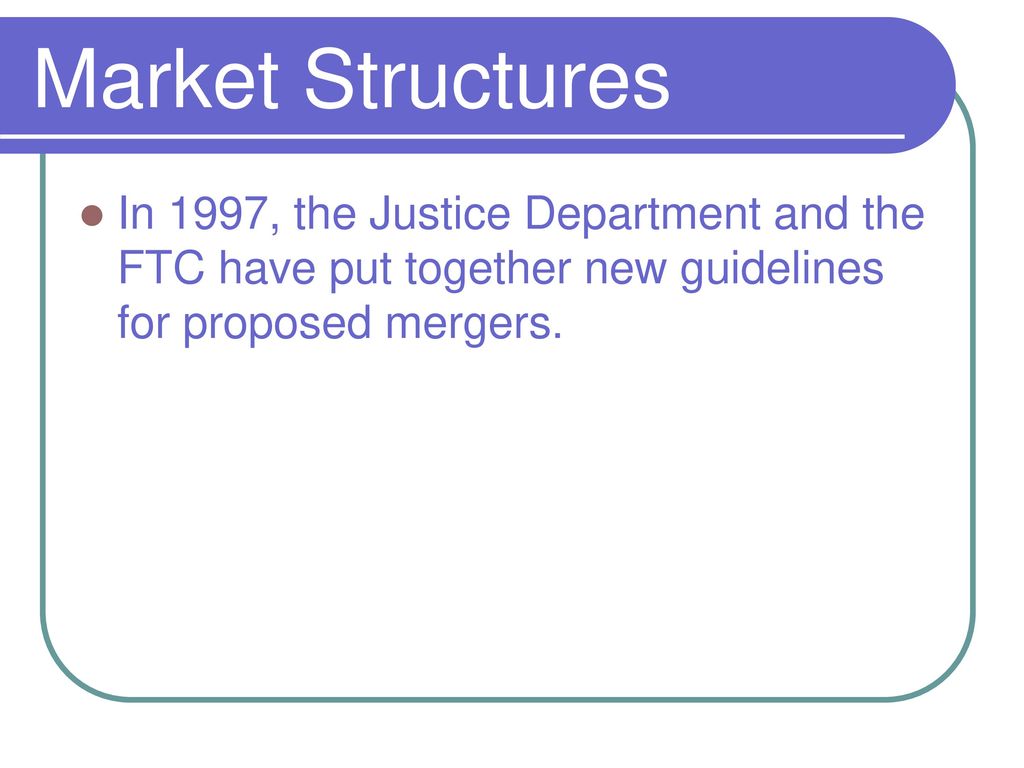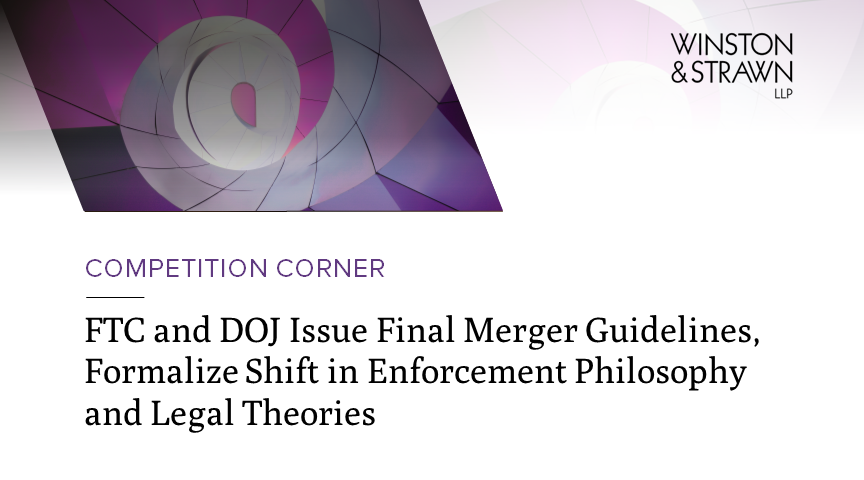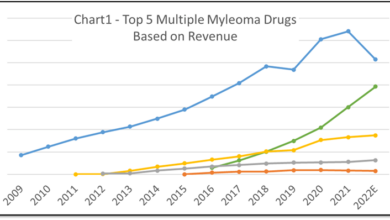
FTC DOJ Final Merger Guidelines Healthcare
FTC DOJ final merger guidelines healthcare: These guidelines are shaking up the healthcare industry, and I’m here to break down what it all means. For years, mergers in healthcare have been a hot topic, raising concerns about rising costs and reduced access to care. These new guidelines aim to address those concerns, but the implications are far-reaching and complex.
Think hospital systems joining forces, pharmaceutical giants merging, and the impact on everything from drug prices to your health insurance premiums. It’s a game changer, and understanding the details is crucial.
We’ll explore the history of these guidelines, looking at how they’ve evolved over time and examining some landmark mergers that shaped the landscape. We’ll then dive into the specifics of the new rules, analyzing how they affect different sectors of the healthcare industry, from hospitals and pharmaceuticals to medical devices and insurance. We’ll also consider the potential antitrust concerns, the enforcement mechanisms, and the critical role of economic modeling in evaluating these complex mergers.
Finally, we’ll examine the impact on public health, a key consideration in these decisions.
Historical Context of FTC and DOJ Merger Guidelines in Healthcare
The evolution of merger guidelines in the healthcare industry reflects a complex interplay of economic theory, political pressures, and technological advancements. Early guidelines focused primarily on preventing monopolies and maintaining competition among hospitals and insurers. However, the increasing complexity of the healthcare market, driven by factors such as managed care, pharmaceutical innovation, and the rise of large integrated delivery systems, has necessitated a more nuanced and sophisticated approach to merger review.The historical context reveals a gradual shift from a relatively narrow focus on market share to a broader consideration of potential anti-competitive effects, including those that might not be immediately apparent in traditional market analysis.
This includes a growing recognition of the importance of considering the impact of mergers on innovation, access to care, and quality of services.
Evolution of Merger Enforcement Approaches
Early enforcement efforts largely focused on preventing horizontal mergers that directly reduced the number of competitors in a specific geographic market. As the healthcare industry consolidated, however, the focus broadened to include vertical mergers (between entities at different stages of the healthcare supply chain, such as a hospital and a physician practice) and conglomerate mergers (between unrelated healthcare entities).
The agencies began to utilize more sophisticated economic modeling techniques to assess the potential competitive effects of mergers, incorporating data on patient flows, physician referral patterns, and the pricing of healthcare services. A significant shift occurred with the increased attention paid to the potential for mergers to stifle innovation, particularly in the pharmaceutical and biotechnology sectors.
Examples of Past Mergers and Their Impact
The merger between Aetna and Humana in 2017, for example, faced significant regulatory scrutiny due to concerns about reduced competition in certain geographic markets and the potential for higher insurance premiums. Similarly, the proposed merger between Anthem and Cigna in 2016 was ultimately abandoned in the face of strong opposition from the DOJ. These cases highlight the evolving standards used to evaluate mergers and the agencies’ increasing willingness to challenge transactions with potentially significant anti-competitive effects, even if the immediate impact on market share appears modest.
Conversely, some mergers, while initially raising concerns, have been approved after the merging parties made concessions, such as divestitures of assets or commitments to maintain certain levels of competition. These outcomes reflect the iterative and case-specific nature of merger review.
Rationale Behind Past Guideline Revisions
Revisions to the merger guidelines often reflect changes in the healthcare market itself, advancements in economic analysis, and evolving interpretations of antitrust law. For instance, the increased emphasis on evaluating the potential impact of mergers on innovation is a direct response to the growing importance of research and development in the pharmaceutical and biotechnology industries. The guidelines have also been revised to better account for the unique characteristics of different healthcare markets, recognizing that the competitive dynamics of hospital markets may differ significantly from those of pharmaceutical markets.
These revisions reflect a continuous effort by the FTC and DOJ to adapt their enforcement approaches to the ever-changing landscape of the healthcare industry. The agencies have sought to clarify and refine their analytical frameworks, striving for greater transparency and predictability in the merger review process while maintaining a strong commitment to protecting competition and ensuring access to affordable, high-quality healthcare.
Key Provisions of the Final Merger Guidelines

Source: slideplayer.com
The newly released FTC and DOJ merger guidelines for the healthcare industry represent a significant shift in how authorities will assess proposed mergers and acquisitions in this vital sector. These guidelines aim to provide clearer and more robust criteria for evaluating the competitive impact of such deals, particularly focusing on preventing anti-competitive outcomes that could harm patients and stifle innovation.
The updated guidelines incorporate lessons learned from past enforcement actions and reflect a heightened awareness of the unique dynamics within the healthcare market.
Criteria Used to Evaluate Healthcare Mergers
The guidelines establish a multi-faceted approach to evaluating healthcare mergers, going beyond simple market share analysis. They emphasize a detailed examination of the merging firms’ competitive interactions, including factors like the overlap in services offered, geographic reach, and the presence of alternative providers. The agencies will scrutinize the potential for the merged entity to exercise market power, leading to higher prices, reduced quality of care, or decreased innovation.
For instance, a merger between two major hospital systems in a sparsely populated region might be viewed differently than a merger between two specialty clinics in a densely populated urban area with numerous competitors. The analysis considers not only direct competition but also potential effects on competition from related services or products.
Market Concentration Thresholds Triggering Scrutiny
While the guidelines don’t explicitly state specific numerical thresholds for market concentration (like the Herfindahl-Hirschman Index or HHI), they signal a significantly lower tolerance for mergers that increase concentration, particularly in already concentrated markets. The agencies will consider the overall market structure, the presence of any significant barriers to entry for new competitors, and the potential for the merged entity to unilaterally raise prices or reduce output.
Previous guidelines might have allowed mergers that resulted in moderate increases in concentration, but the updated guidelines suggest a more stringent approach, prioritizing the prevention of even subtle anti-competitive effects. This is especially relevant in markets with limited competition, such as specialized medical services or pharmaceuticals.
Application of the “Substantial Lessening of Competition” Standard
The “substantial lessening of competition” (SLC) standard remains the cornerstone of merger review. However, the guidelines provide a more detailed and nuanced interpretation of this standard in the healthcare context. The agencies will consider a broader range of factors beyond traditional market share analysis, including the merging firms’ ability to coordinate pricing, their control over essential inputs (like specialized equipment or pharmaceuticals), and the potential for the merger to stifle innovation.
The analysis will consider the impact on both the short-term and long-term competitive landscape, acknowledging that the effects of a merger may not be immediately apparent. For example, a merger might lead to the elimination of a particularly innovative competitor, hindering future technological advancements in the field.
Comparison with Prior Versions
The current guidelines represent a departure from prior versions in their emphasis on the unique characteristics of the healthcare market. Previous guidelines often treated healthcare markets similarly to other industries. The updated guidelines acknowledge the significant role of government regulation, insurance reimbursement, and network effects in shaping healthcare competition. They also explicitly address concerns about the potential for mergers to reduce innovation and the quality of care, placing greater emphasis on patient welfare.
This shift reflects a growing understanding of the complexities of the healthcare market and a greater focus on preventing mergers that could harm patients. The increased scrutiny on mergers involving providers of essential healthcare services underscores the agencies’ commitment to maintaining competitive pressure in this critical sector.
Impact on Different Healthcare Sectors
The revised FTC and DOJ merger guidelines significantly alter the landscape for mergers and acquisitions across various healthcare sectors. These guidelines, with their increased scrutiny of potential anti-competitive effects, will likely lead to more rigorous reviews and potentially fewer mergers approved, especially those involving large players. The impact will vary depending on the specific sector and the nature of the proposed merger.
Hospital Mergers
The implications of the new guidelines for hospital mergers are substantial. Increased consolidation in the hospital industry has long been a concern, raising questions about reduced competition, higher prices, and decreased quality of care. The stricter guidelines aim to address these concerns by focusing on the potential for increased market concentration and reduced patient choice.
| Sector | Potential Impact | Examples of Past Mergers |
|---|---|---|
| Hospital Mergers | Increased scrutiny of mergers, potentially leading to more denials or requests for significant divestitures to mitigate anti-competitive effects. Higher likelihood of challenges from the FTC and DOJ. Increased focus on geographic market definition and the impact on patient access to care. | The merger between Advocate Health Care and NorthShore University HealthSystem in Illinois faced significant regulatory hurdles and ultimately required divestitures to gain approval. Similarly, the proposed merger between Providence Health & Services and St. Joseph Health was abandoned after facing intense regulatory scrutiny. |
Pharmaceutical Mergers
Pharmaceutical mergers have the potential to significantly impact drug pricing and innovation. The new guidelines will likely lead to a more in-depth analysis of the impact on competition in the research, development, and distribution of pharmaceuticals. The FTC and DOJ will likely scrutinize whether mergers could lead to reduced innovation, higher drug prices, or limited access to essential medications.
Concerns about the elimination of potential competitors and the stifling of generic drug development will be central to the review process.
Medical Device Mergers
The medical device industry is characterized by significant innovation and technological advancements. Mergers in this sector can lead to both benefits and drawbacks. While consolidation might facilitate economies of scale and accelerate innovation in some cases, it can also reduce competition, leading to higher prices and potentially slower innovation if smaller, more nimble competitors are eliminated. The new guidelines will carefully examine the potential for reduced competition, reduced choice for healthcare providers, and ultimately, higher costs for patients.
Health Insurance Mergers
The health insurance industry is another sector facing intense scrutiny under the new guidelines. Mergers in this sector can significantly impact the cost and availability of health insurance plans. The guidelines will focus on whether mergers lead to higher premiums, reduced network choices for consumers, and ultimately, limited access to affordable and quality healthcare. The FTC and DOJ will likely scrutinize the impact on competition among insurers, the potential for increased market power, and the consequences for consumers.
Potential Antitrust Concerns
The revised FTC and DOJ Merger Guidelines for healthcare aim to address potential anti-competitive effects stemming from hospital and healthcare system mergers. These guidelines scrutinize mergers more rigorously, focusing on the potential for reduced competition and its impact on patients and the healthcare system as a whole. Understanding the potential antitrust concerns is crucial for evaluating the long-term consequences of these mergers.The primary concern revolves around the potential for mergers to create or enhance market power, leading to anti-competitive outcomes.
This translates to higher prices for patients, reduced choices in healthcare providers, and potentially, diminished innovation in the sector. Market power, in this context, refers to the ability of a merged entity to exert significant influence over prices and output in a given market. The guidelines provide a framework for evaluating this power and its potential impact on competition.
The FTC and DOJ’s final merger guidelines for healthcare are raising a lot of questions about market consolidation, and one area of concern is the potential impact on staffing. The increasing demand for medical coders is a huge issue, and finding a solution is critical. Addressing this shortage could be partially solved by innovative technologies, like those described in this article about the ai powered solution to the medical coding worker shortage , which could alleviate some of the pressures driving consolidation.
Ultimately, the FTC and DOJ guidelines need to consider these technological advancements when evaluating mergers in the healthcare sector.
Market Power and Merger Evaluation
Assessing market power is central to the antitrust review process. The agencies will consider the market share of the merging entities, the concentration of the market after the merger, and the presence of other competitors. A high market share post-merger, coupled with limited competition, raises significant concerns about the potential for price increases and reduced service quality. For instance, a merger resulting in a combined entity controlling 80% of a local hospital market would likely face intense scrutiny.
The agencies may also analyze the merged entity’s ability to exert buyer power over suppliers, such as pharmaceutical companies or medical device manufacturers, leading to lower payments to suppliers and potentially impacting innovation. This evaluation often involves sophisticated econometric modeling and analysis of historical pricing data.
Barriers to Entry in Healthcare Markets
The presence or absence of barriers to entry is another critical factor in the antitrust assessment. High barriers to entry make it difficult for new competitors to enter the market, even if prices are artificially inflated. These barriers can include high capital costs for building new hospitals or clinics, regulatory hurdles such as obtaining licenses and approvals, and the difficulty of recruiting qualified medical professionals.
If barriers to entry are high, a merger that increases market concentration is more likely to result in sustained anti-competitive effects, as new entrants cannot easily counteract the merged entity’s market power. For example, the high cost of establishing a new specialized cardiac care center would serve as a substantial barrier to entry, making a merger in that specific niche particularly concerning.
Analysis of Potential Efficiencies
While mergers can potentially lead to anti-competitive effects, the guidelines also acknowledge that they can generate efficiencies that benefit consumers. These efficiencies could include improved quality of care, reduced costs through economies of scale, and the introduction of new technologies or services. However, the agencies will carefully scrutinize claims of efficiencies. They must be verifiable, merger-specific (meaning they wouldn’t occur without the merger), and substantial enough to outweigh any potential anti-competitive effects.
For example, a merger might claim cost savings through consolidation of administrative functions. However, these savings must be demonstrably significant and not simply offset by increased prices or reduced service quality. The agencies will require rigorous evidence to support any claims of efficiency gains. Furthermore, efficiencies must be passed on to consumers in the form of lower prices or improved services to be considered a legitimate counterweight to anti-competitive concerns.
Enforcement Mechanisms and Remedies

Source: winston.com
The revised FTC and DOJ merger guidelines for healthcare significantly impact how proposed mergers are reviewed and challenged. Understanding the enforcement mechanisms and available remedies is crucial for both merging entities and the healthcare industry at large. This section details the procedures involved in merger review, the types of remedies employed to address anti-competitive concerns, and provides examples of past merger challenges, both successful and unsuccessful.
Merger Review Procedures
The process begins with pre-merger notification, typically under the Hart-Scott-Rodino Antitrust Improvements Act of 1976 (HSR Act). This requires parties to a significant merger to notify both the FTC and DOJ before the transaction closes, allowing agencies time for review. The agencies assess the proposed merger’s potential impact on competition, considering factors such as market definition, market concentration, and the merging parties’ market power.
Investigations may involve extensive document requests, interviews with company executives, and analysis of market data. The agencies can choose to challenge a merger through an administrative complaint or file suit in federal court to block the transaction. The timeline for review can vary significantly, depending on the complexity of the merger and the cooperation of the involved parties.
In some instances, the agencies may negotiate with the merging companies to secure concessions that mitigate anti-competitive concerns, resulting in a consent decree.
Types of Remedies for Anti-Competitive Concerns
If the agencies determine that a merger is likely to substantially lessen competition, they can employ several remedies. These include structural remedies, such as divestitures (selling off assets or business units), and behavioral remedies, such as commitments to maintain specific levels of competition or to refrain from certain anti-competitive actions. Divestiture might involve selling off a specific hospital, clinic, or pharmaceutical division to ensure the continued presence of a competitive entity in the market.
Behavioral remedies might involve agreements to license intellectual property, to avoid exclusive contracts with providers, or to refrain from price-fixing activities. The choice of remedy depends on the specifics of the merger and the agencies’ assessment of its potential impact. The goal is to restore or maintain competition to a level that would have existed without the merger.
Examples of Merger Challenges
The merger of two large hospital systems in a geographically limited area, resulting in a significant increase in market concentration, could be challenged. If the agencies found that the merger would likely lead to higher prices and reduced quality of care, they might seek a divestiture of one or more hospitals to maintain competition. Conversely, a merger involving two companies with minimal market overlap and demonstrating that the merger leads to significant efficiencies and pro-competitive innovation may be allowed to proceed without any remedies.
A successful challenge could be the blocking of a pharmaceutical merger that would have resulted in a monopoly on a particular drug, while an unsuccessful challenge might involve a merger where the agencies determined that the potential benefits outweighed the anti-competitive risks. Specific examples are numerous and publicly available in FTC and DOJ records, but detailing them would require lengthy descriptions and citation of specific cases.
Hypothetical Merger Review Scenario, Ftc doj final merger guidelines healthcare
Imagine two large pharmaceutical companies, PharmaCorp and MedTech, announce plans to merge. Both companies produce several competing drugs in the cardiovascular market. Under the HSR Act, they would file a pre-merger notification with the FTC and DOJ. The agencies would then conduct an extensive investigation, defining the relevant market, analyzing market concentration, and evaluating the potential for price increases or reduced innovation post-merger.
If the agencies determined that the merger would substantially lessen competition, they might require PharmaCorp and MedTech to divest a specific drug or a particular division related to cardiovascular drugs to maintain competition. The companies could negotiate a consent decree with the agencies, agreeing to these divestitures to avoid a full-blown court challenge. Alternatively, if the agencies determined the merger would result in significant efficiencies without substantially lessening competition, they might allow the merger to proceed without any conditions.
Economic Modeling and Data Analysis in Merger Review
The FTC and DOJ employ sophisticated economic modeling and data analysis techniques to assess the potential competitive effects of mergers in the healthcare sector. These methods go beyond simple market share calculations, delving into the intricacies of market structure, firm behavior, and consumer response to understand the true impact of a proposed merger. The goal is to predict whether the merger will likely lead to higher prices, reduced innovation, or less choice for patients and providers.
Market Concentration and Competition Analysis
Analyzing market concentration involves measuring the extent to which a small number of firms control a significant portion of the market. The Herfindahl-Hirschman Index (HHI) is a commonly used metric. The HHI is calculated by summing the squares of the market shares of all firms in the market. A higher HHI indicates greater concentration. The guidelines consider post-merger HHI levels and changes in HHI to assess the degree of market concentration.
For example, a merger resulting in a significant increase in HHI in an already concentrated market raises significant concerns. Beyond the HHI, analysis also includes examining the market shares of the merging firms, the presence of potential competitors, and the ease of entry and exit from the market.
Econometric Models in Merger Review
Econometric models are statistical tools used to quantify the relationships between variables, allowing for predictions about the impact of a merger. These models can incorporate data on prices, quantities, costs, and other relevant factors to estimate the likely effects of the merger on prices, output, and consumer welfare. For instance, a merger simulation model might predict price increases resulting from a reduction in competition post-merger, comparing those predictions to a counterfactual scenario where the merger does not occur.
The complexity of these models varies depending on the data available and the specific market characteristics. They can range from simple regression models to sophisticated structural models that explicitly account for firm interactions and strategic behavior.
The FTC and DOJ’s updated merger guidelines for healthcare are raising a lot of questions about vertical integration. One example that immediately springs to mind is the expansion of humana centerwell primary care centers walmart , which highlights the complexities of these guidelines in practice. Ultimately, the impact of these guidelines on such partnerships remains to be seen, shaping the future of healthcare delivery.
Market Definition in Assessing Competitive Effects
Defining the relevant market is crucial for assessing competitive effects. The relevant market includes all products or services that are considered close substitutes by consumers. A narrow market definition may lead to an overestimation of market concentration, while a broad definition may underestimate it. The agencies use various methods to define the relevant market, including examining price correlations, consumer substitution patterns, and the geographic area in which firms compete.
For example, in the hospital market, the relevant geographic market might be defined based on patient travel patterns, while in the pharmaceutical market, it might be defined based on the therapeutic substitutability of drugs. Accurate market definition is paramount to ensure the reliability of concentration measures and competitive effect analysis.
Hypothetical Example of Economic Data Use in Merger Decisions
Imagine two large hospital systems in a rural area are proposing a merger. The agencies would first define the relevant geographic market, perhaps using patient travel data to determine the area from which patients typically seek hospital services. They would then calculate the HHI for the hospital market, noting the pre-merger and post-merger levels. A significant increase in the HHI would raise concerns.
Econometric models could then be used to estimate the impact of the merger on hospital prices, potentially comparing prices in the merged market to prices in comparable markets where no such merger occurred. Data on hospital costs, patient volumes, and payer reimbursement rates would inform the models. If the models predict substantial price increases for a range of plausible scenarios, the agencies might challenge the merger.
Conversely, if the models suggest minimal price impact, and the agencies find no evidence of other anticompetitive effects, the merger may be allowed to proceed.
Public Health Implications of Healthcare Mergers
The revised FTC and DOJ merger guidelines for healthcare have significant implications for public health, extending beyond the purely economic considerations of competition. Understanding these implications is crucial for ensuring that mergers, while potentially beneficial in some ways, do not ultimately harm patient access, quality of care, or overall population health. The guidelines aim to address these concerns proactively, but careful monitoring and enforcement will be essential.The potential impact of healthcare mergers on public health is multifaceted, with both positive and negative possibilities.
While some mergers might lead to economies of scale and improved efficiency, resulting in lower costs and better services, others could lead to reduced access, compromised quality, and ultimately, poorer health outcomes for vulnerable populations.
The FTC and DOJ’s final merger guidelines for healthcare are definitely going to impact innovation, and it makes me wonder about the long-term implications. For example, the recent news that the FDA approved clinical trials for pig kidney transplants in humans, as reported on this site , highlights the kind of groundbreaking medical advancements that could be affected by stricter merger rules.
Will increased regulatory scrutiny stifle this kind of progress? It’s a crucial question considering the future of healthcare.
Access to Care
Reduced access to care is a major concern arising from healthcare mergers. Large hospital systems, for instance, may consolidate services, closing smaller facilities in less profitable areas. This can leave patients, particularly those in rural or underserved communities, with fewer choices for care and increased travel distances. The closure of a local hospital, for example, could significantly impact access to emergency services, routine checkups, and specialized treatments, potentially leading to worse health outcomes due to delayed or forgone care.
The guidelines aim to mitigate this by considering the impact on access, particularly for vulnerable populations, in their merger reviews.
Effects on Healthcare Quality
The effect of mergers on healthcare quality is complex. While some mergers may lead to improved quality through investments in technology and personnel, others may lead to a decline in quality due to factors like reduced staffing levels, decreased investment in facilities, or a shift in focus from patient care to cost-cutting measures. For example, a merger that leads to the elimination of specialized services at one of the merging facilities could negatively impact the quality of care available to patients who previously relied on those services.
Similarly, mergers that result in reduced staffing ratios could negatively impact patient safety and care quality.
Consideration of Patient Welfare in Merger Reviews
The revised guidelines explicitly emphasize the importance of patient welfare in merger reviews. This includes a comprehensive assessment of the potential impact on access to care, quality of care, and patient choice. The agencies are now required to consider not just the economic effects of a merger but also its potential consequences for patients’ health and well-being. This shift in focus reflects a growing recognition that the healthcare market is fundamentally different from other markets, and that the welfare of patients must be a central consideration in merger decisions.
The emphasis on data and economic modeling aims to provide a more robust and evidence-based assessment of these potential impacts.
Role of Consumer Choice in Healthcare Markets
Consumer choice plays a vital, albeit often constrained, role in healthcare markets. Mergers that reduce the number of providers or limit the range of services available can significantly restrict consumer choice, potentially leading to patients being forced to accept less desirable options or forgo care altogether. For example, if a merger results in a single provider dominating a geographic area, patients may have limited options for selecting a physician or hospital, potentially impacting their ability to find a provider who is a good fit for their needs and preferences.
The guidelines acknowledge the importance of consumer choice and aim to ensure that mergers do not unduly restrict this choice. However, the limitations of consumer choice in healthcare, due to factors such as information asymmetry and the complexity of medical decisions, are also acknowledged.
Closure: Ftc Doj Final Merger Guidelines Healthcare
The FTC and DOJ’s final merger guidelines for healthcare represent a significant shift in how we approach consolidation within this vital sector. While aiming to protect competition and patient welfare, the implementation and long-term effects remain to be seen. The complexities of market analysis, the potential for both positive and negative consequences, and the ongoing debate surrounding access, affordability, and innovation highlight the ongoing importance of monitoring these developments.
This is a story that’s still unfolding, and staying informed is more important than ever.
Questions Often Asked
What are the potential benefits of healthcare mergers, if any?
Proponents argue that mergers can lead to increased efficiency, economies of scale, and investment in new technologies and services. However, these potential benefits must be carefully weighed against the risks to competition.
How are “substantial lessening of competition” and market concentration determined?
This involves complex economic analysis, including market definition, concentration measures (like the Herfindahl-Hirschman Index or HHI), and assessment of barriers to entry. The guidelines provide detailed guidance, but each case is fact-specific.
What remedies might the FTC or DOJ pursue if a merger is deemed anti-competitive?
Remedies can range from requiring divestitures (selling off assets) to behavioral remedies (restrictions on conduct) to blocking the merger altogether. The choice of remedy depends on the specific anti-competitive concerns identified.
How can consumers get involved in the merger review process?
The public often has opportunities to submit comments during the review process. Information on how to do so is typically available on the FTC and DOJ websites.





